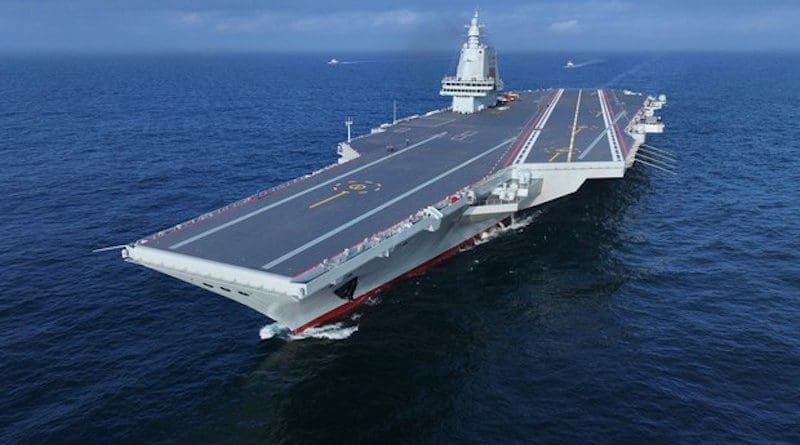China’s Third Aircraft Carrier Completes First Sea Trial
By RFA
Satellite imagery shows China’s third aircraft carrier Fujian has returned to Shanghai Jiangnan Shipyard after completing an eight-day maiden sea trial.
In a Planet Labs image from May 9, 2024, obtained by Radio Free Asia, the Fujian was seen moving back to its berth at Jiangnan, where it was built and fitted out over the last six years.
During the sea trial that began on May 1, the carrier tested its propulsion and electrical systems and other equipment, and “achieved the expected results,” according to China Military Online.
It will conduct follow-up tests according to established plans, the People’s Liberation Army’s news outlet said.
“If previous experience is any guide, we can expect three to five months of sea trials to ensure the integrity of the hull and propulsion systems,” said Robert Farley, a senior lecturer at the University of Kentucky.
“If everything goes well, Fujian could begin flight operations this year,” Farley said, adding that it could take a year or more for the aircraft carrier to “actually be operational.”
Fujian will likely host Shenyang J-15 fighters, as well as the next generation J-35s, JL-10 trainer jets and the new Xian KJ-600 fixed-wing AEWC (airborne early warning and control) aircraft. The airplanes would be launched from the carrier’s deck by a modern system called Catapult Assisted Take-Off Barrier Arrested Recovery (CATOBAR) that so far has only been used by the U.S. and French navies.
It is the first Chinese aircraft carrier equipped with CATOBAR. China’s first two flattops – Liaoning and Shandong – use a ski jump-style launch system. The CATOBAR system is able to launch more and heavier aircraft than the ski jump system.
At 80,000 tons, Fujian is of the same size as a U.S. Nimitz-class carrier but smaller than the new Gerald R. Ford carrier of 100,000 tons.
“Even after commissioning the Chinese will still have lots to learn, so we can expect Fujian to operate at a slower pace than a U.S. supercarrier, even given the differences in size,” said Farley.
However, at the end of this process China will have “a very advanced carrier, probably more advanced and capable than the carriers currently operated by France or the United Kingdom,” the maritime affairs expert told RFA.
Strategic platform
The Chinese navy released a number of photographs and a nearly eight-minute video showing the Fujian’s movements during the sea trial.
Chinese experts were quoted by the Global Times as saying that the successful maiden voyage “has laid a solid foundation for future test voyages, and marks a concrete step toward its commissioning” into the navy.
The fleet of three aircraft carriers would boost the navy’s combat capability and serve as strategic platforms to safeguard China’s sovereignty, they said.
China already has numerically the largest navy in the world with an overall battle force of over 370 ships and submarines, compared with the U.S.’s 293 ships and submarines. It also has the largest coast guard fleet in the world, besides a powerful maritime militia.
A report by the U.S. think-tank Center for Strategic and Budgetary Assessments said that in addition to its three aircraft carriers, China may build another two in the next 10 years.
“No one would ever go through the process of learning CATOBAR operations just to build one carrier, so I expect that we’ll see at least one more ship of Fujian’s type,” Farley said.

